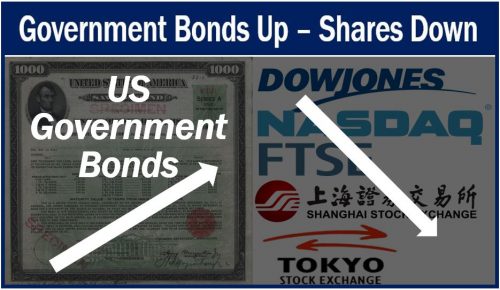Jittery investors fled to US government bonds, a perceived haven, in New York early Thursday. The move brought a temporary halt to a rapid increase in yields. Yields in US government bonds climbed rapidly after the worst fall for equity benchmarks since February 2018.
The ten-year Treasury note yield TMUBMUSD10Y declined by 6.3 basis points to 3.158%. Earlier in the day, it had reached a near 7-year intraday high.
TMUBMUSD02Y, the two-year note yield, fell 3.7 basis points to 2.844%. TMUBMUSD30Y, the 30-year bond yield, dropped 5.7 basis points to 3.340%. Yesterday, it had reached a four-year high.
When bond prices rise, yields fall. Conversely, when bond prices fall, yields rise.
Bonds pulled back worldwide. TMBMKDE-10Y, Germany’s ten-year bond (the bund), declined from 0.566% on Wednesday (yesterday) to 0.510% on Thursday (today).

US Government bonds vs. stock market
Stock markets in North America, Europe, and Asia, have fallen steeply since yesterday morning. The Dow Jones Industrial Average fell by 3.3% or over 830 points. It was the largest fall since February 2018.
The Nasdaq Composite Index fell by 4.1%. Most major technology companies’ share prices are quoted in Nasdaq.
On Wednesday, Nasdaq experienced its steepest decline since June 2016; when Britain voted for Brexit. Brexit stands for BRitain EXITing the European Union.
Politicians, economists, newspapers, and specialist journals are attributing the recent stock market decline to several factors:
- America’s trade dispute with China is affecting investment and confidence.
- The US Federal Reserve has been raising interest rates. So far this year, it has raised rates three times. The Federal Reserve System (Federal Reserve or the Fed) is the United States’ central bank.
- The International Monetary Fund has cut its growth forecast for the global economy to 3.7% from 3.9%.
In a rally in Erie, Pennsylvania, President Donald Trump said:
“I think the Fed is making a policy error. It’s so tight, I think the Fed has gone crazy.”
